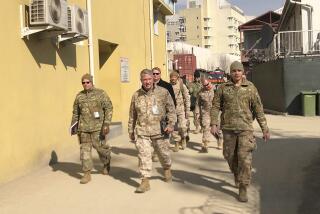The war’s real report card
- Share via
The Obama administration’s year-end review of its strategy in Afghanistan and Pakistan, released last week, was intended to be cautiously reassuring: Yes, there are challenges, but military progress is being made. Overall, President Obama said, “We are on track to achieve our goals.”
On closer reading, though, even the carefully written five-page public summary of the review isn’t as reassuring as some of the headlines it earned. In Afghanistan, it says, the growth of the Taliban insurgency has been slowed, but that achievement is “fragile and reversible.” In Pakistan, progress in the shadowy war against extremists has been “substantial,” but not enough to deny either Al Qaeda or the Afghan Taliban the havens that shelter them from defeat; that will require much more military action than the Pakistanis have been willing to undertake so far.
And the report — at least the public version — barely mentioned some of the most daunting problems facing the U.S. in Afghanistan. “Emphasis must continue to be placed on the development of Afghan-led security and governance,” it said. Translation: In many areas, there’s still no functioning Afghan government or police force. The word “corruption” never appeared; the administration’s rocky relationship with Afghanistan’s mercurial president, Hamid Karzai, got no mention. Nor did it make much of a case that Pakistan, which is focused on its own problems, is likely to commit more troops and take more risks to help the U.S. and Afghanistan.
More important, the report’s on-the-ground focus meant it also largely ignored three of the biggest factors shaping the future of the U.S. enterprise in Afghanistan and Pakistan: time, cost and the support of the American people.
The U.S.-led war in Afghanistan is already in its 10th year, even though (as administration officials often point out) it has only been waged at its current full strength of 140,000 American and allied troops for the last six months. Initially, U.S. military officials hoped to show quick successes on the ground that would provide what they call “proof of concept” in time for last week’s report. That timetable, like every timetable in Afghanistan, has slipped; proof of concept is now on the agenda for a full review that is scheduled for July 2011.
Some military officers are already saying that even then they may need more time to show what they can do, and they are readying their arguments in favor of the slowest possible drawdown of troops.
The United States and NATO have embraced Karzai’s target of turning over principal responsibility for the war to Afghan forces by the end of 2014, but that goal is only “aspirational,” a Pentagon spokesman has said. (Moreover, he added, “It’s the end of 2014, so effectively that’s 2015.”) And handing off to the Afghans won’t mean a complete withdrawal of U.S. troops; officials have estimated that at least 35,000 would stay behind as advisors, even under a best-case scenario.
The longer the war continues, the more it costs in both lives and money. Because of stepped-up military operations, U.S. deaths in Afghanistan are on track to reach 500 this year, up from 317 last year. The financial cost is heavy too — more than $100 billion a year, money the cash-strapped U.S. government can ill-afford. In a report of its own last month, the Council on Foreign Relations — the heart of the traditional foreign policy establishment — warned: “We are mindful of the threat we face. But we are also aware of the costs of the present strategy. We cannot accept these costs unless the strategy begins to show signs of progress.”
Given the toll in casualties and costs, it’s not surprising that public support for the war has eroded. A poll by the Pew Research Center last month found for the first time that more Americans (47% versus 44%) favor an early withdrawal from Afghanistan over staying until the country is stabilized.
Obama has built escape hatches into his policy if it begins to look as if the current strategy isn’t working. The president didn’t fully embrace the ambitious counterinsurgency strategy proposed by Gens. Stanley A. McChrystal and David H. Petraeus last year; instead, he gave them enough troops for a limited version, with a deadline of July 2011 to start downsizing. (Last week, Obama credited the deadline’s galvanizing effect for much of the progress reported in the review.)
He insisted, as he has before, that U.S. goals in Afghanistan are limited to denying a haven to Al Qaeda. “It’s not nation-building,” he said, even though nation-building is normally part of effective counterinsurgency. He promised to stay committed to the fight against terrorism, but carefully didn’t tie himself to any one strategy.
Still, Obama’s decisions on the war so far have been to give his military commanders what they requested with only modest adjustments. His course has been marked by caution, not audacity. So even though he faces a more serious strategic decision by July 2011, the pattern so far suggests that he’s likely to make another incremental decision — a modest drawdown of troops, followed by another review in another six months.
So where do we stand? As Obama said, “We are on track to achieve our goals.” But we are on track to achieve them some time after 2015, when the U.S. forces in Afghanistan will be in their 15th year of the war.
More to Read
Get the L.A. Times Politics newsletter
Deeply reported insights into legislation, politics and policy from Sacramento, Washington and beyond. In your inbox twice per week.
You may occasionally receive promotional content from the Los Angeles Times.











